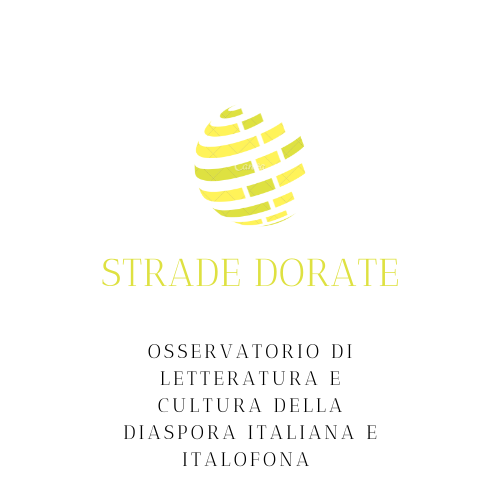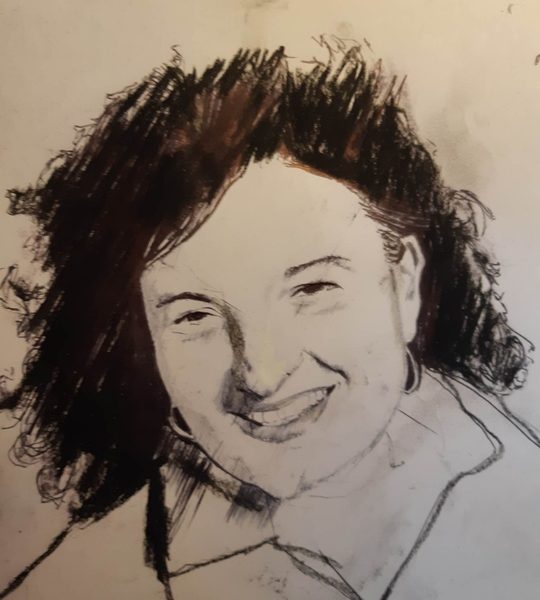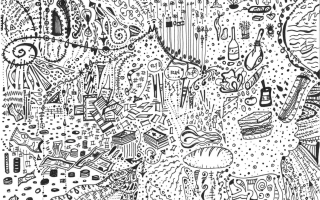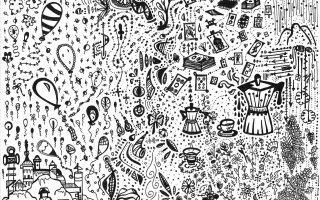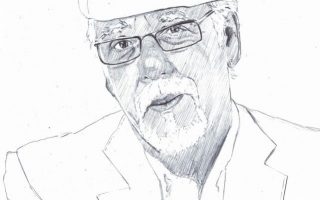by ROSA AMATULLI
American born, Louisa Calio is a poet, writer and artistic performer, whose work has been described as possessing “a sensitivity to multiculturalism and ethnic diversity that is sometimes lacking in Italian American culture” (Stanislao Pugliese), and “a profound passion for the lyrical,” (Henry Louis Gates, Jr.).Winner ofnumerous awards in Italy and in the USA, including the Renaissance Award from Italian Charities of America in 2022, she has been a force in public arts. In 1987 Barnard College acknowledges her leadership in the arts, and in 2006 names her as a “Feminist who changed America.” Currently shecontinues to explore and express her creativity through varying mediums, such as, among others, performance poetry, music, and photography. Her life and work have taken her to East and West Africa, as well as to Jamaica (WI), and Italy, where she found sources of inspiration for her artistic creations.
Hello Louisa. On behalf of Strade Dorate, I’d like to thank you for this opportunity to learn about you, in this Zoom conversation. In your writing you often refer to the experience of Italian-Americans here in America, and to your Italian roots. Do you consider yourself American or Italian-American?
Thank you, Rosa, for this opportunity. In my essay, “My Italian/ Sicilian/American Soul” (Ameri-Sicula: Sicilian Culture in America) I wrote about the competing parts of myself that emerged while growing up Italian-Sicilian-American in the 1950s. I said my soul was Italian, referring to the roots of my ancestors that were carried in my DNA, and steeped in a longer history which ultimately goes back to Africa. This was manifested in many ways: my early attractions to Egypt, the African continent, Greece, Sicily, and a huge eye I would commonly draw as a child. To my surprise, I would later find a similar eye in the domeof the Cathedral of Siracusa, in Sicily, when I traveled there on tour with Arba Sicula, in 2013. I also realized that somehow, my poetry and my performances echoed the rituals of the Black Madonna in Trapani.
I grew up in Brooklyn, NY, in an Italian home filled with Italian customs and traditions. When I was a teen we moved to Long Island, where I became “Americanized.” I sang and danced to the songs of my generation, which emerged from African-American culture, and loved the worldviews of poets like, Langston Hughes and Sterling Brown. The prejudices and economic hardships they were subjected to in the USA, were similar to my family’s.
I attended SUNY Albany, from 1966 to 1969, obtaining a BA, Magna Cum Laude & Special Honors in English; and Temple University, in 1973, to get a Master’s Degree. During these years I was swept up into idealistic waves: I marched against the war in Vietnam, and for minority and women’s rights. On graduation I worked in the inner city of Albany with displaced and minority children and adults.
What is your relationship with Italy and its culture?
I now believe unconsciously I have sought to know Italy through my travels. My trips there helped to satisfy my need to touch and feel the land of my people and to know their works of art and architecture. History and art books, show us images of all the artistic achievements of the ancient Romans, and of the Italian people, but do not awake any emotion in us. On the other hand, visiting the Pantheon, the Colosseum, Bernini’s bronze sculptures in the Vatican, Michelangelo’s Pietà, and other artistic beauties, I cried.
The trip I made to Sicily after my mother’s death in 2013, was life changing. This island, with so much beauty, had a complex history. The many nations that invaded it, left their devastating, and enriching, marks everywhere. While walking through the streets of Sicily, I felt pleasantly overwhelmed by all the Greek, the Arab, and the Roman artwork that embellished Palermo, Agrigento, Trapani, and the other cities that I visited. The art, the customs, and the cultural expressions of these “foreigners” turned Sicily into a truly multicultural mosaic. I feel blessed to have roots in a place so culturally rich.
While my studies taught me about ancient and classical Italy, I found I needed to learn more about modern Italy. Through the “Italian American Studies Association” (IASA) I found out about an upcoming conference in Cleveland, Ohio, entitled, “Shades of Black and White: Italy, Africa and the USA.” This fit my interests and decided to attend. There I met Italian and Italian-American scholars, and through their work, I learned about the political and economic circumstances that caused so many Italians to flee their country. A bond was formed, and several of them later read and wrote about my work. Dr. Elisabetta Marino from the Università degli Studi di Roma, Tor Vergata, translated some of my poems into Italian, and Cinzia Marongiu, then a Ph.D student, dedicated some of her work to my poetry. The poet Nino Provenzano, from Castellammare del Golfo (Trapani), translated some of my poems into Sicilian. Scholar, author, activist and professor, Lucia Chiavola Birnbaum and I shared a common fascination for ancient goddesses and the “black madonnas” of the world. Through the years, our intellectual interests turned into a “bridge” that brings the history and culture of the USA closer to Italy and Africa.
What first inspired you to write poetry and, what is poetry for you?
I believe what inspired me to write poetry was a love for listening to both words and music, a great passion for reading and the discovery that poetry could sooth, comfort and speak to me when I felt most alone. I remember as a girl memorizing John Donne’s poem, “For Whom The bell Tolls,” where he says, “no man is an island.” Indeed, we are all part of each other. That poem often came to my aid.
I started writing poetry in my twenties. I wrote, “Beginnings of the Beat,” a poem included in my first collection, In the Eye of Balance, thatdescribes an awakening, a moment of revelation, that called me to begin “to dance” a new dance of my life: poetry.
For me poetry is where the deep-self lives; it’s the voice of our heart. Poetry is perhaps the most intimate way of perceiving the world, and the most personal and affectionate way to express it. The 18th century English poet, William Wordsworth, said it so well in his famous observation on poetry, “poetry is the spontaneous overflow of powerful feelings: it takes its origin from emotion recollected in tranquility” (Lyrical Ballads (1800)). A poet always pays attention to his, or her emotions, and wants to know what causes them. These emotions are an undefended part of ourselves. They are creative and profound.
Can you speak about your poetry in general and, more specifically, about In the Eye of Balance?
Certainly. The poetry I’ve written traces my awakening to a conscious understanding of myself as a woman, and artist, who nurtures a deep interest in, and love for, foreign cultures. Poetry is for me a search for true love and a means for healing; it is how I can unite the masculine and the feminine in me, as well as all the warring parts of myself. This quest goes back to my formative years. Isis, the ancient Egyptian goddess who pieced together the broken body parts of Osiris, symbolized the wholeness I was seeking.
The poetry and the multimedia performances that emerged from my book, In the Eye of Balance, speak of a need to live in harmony, with ourselves and with our nature. These revelations came in verse at a time of my life, when I questioned the roles that I was living and that both my family and society expected of me.
In your writing you often refer to “the feminine.” What does “feminine” mean to you?
I have used the term “feminine” in a traditional way, and within the context of a new feminine arising after two thousand years of patriarchy. In the past the feminine was associated both with the passive and vulnerable, as well as the strength that comes from women’s self-sacrifice. The feminine was also traditionally tied to Eve, in the Bible, who was seen as responsible for Adam’s breaking of God’s law and for being cast out from Paradise.
Many women today are still unable to value and voice their femininity, while others dare to express their desires, hopes and dreams for more than traditional roles. Thanks to movements like Women’s Liberation, Me Too, and Feminism, women now speak openly about the long periods of witch-burnings, torture, repression, and inequality they had to endure, and of the new lives they want to create for themselves. Thanks to such movements, women can now voice all that centuries of a male-defined society denied them.
For me the feminine is all-inclusive, which means we see ourselves in all others, regardless of gender, race, religion, or class. If people paid closer attention to the “feminine” in them, wars and injustice in the world might end. We would no longer feel threatened by “the other” because, as Christianity and all religions teach, we are all one.
Thank you. One of your poems is entitled “Black Madonnas.” Who are they?
I discovered Isis, the original Black Madonna, associated with Nubia and Egypt, at a time in my life, when I needed to learn about self-love. Reading E. A. Budge’s Egyptian Book of the Dead (1895) I learned about the Egyptian trinity: Osiris, Isis, and Horus. It sounded so much like our Christian story, but with one enormous difference. Whereas the Assumption of the Virgin Mary to Heaven doesn’t become official in the Catholic dogma until 1950 by papal decree, Budge maintains that Isis had her own place and voice in the world, as early as ancient Egypt. The idea of having a voice in the world, took hold of me. How can I have a voice, I asked myself, and still care for others, not as a martyr or sacrificial mother, but as an equal? The discovery of the Black Madonnas and the works of Lucia Chiavola Birnbaum, and Mary Beth Moser, and poets like Diana Di Prima, and Ntozake Shange, who write on the “new feminine,” helped me answer those questions and to recreate myself.
The start of a transformation was underway in my twenties. Our ancestor, Eve, who was blamed for the fall from Paradise, was slowly being redeemed. Writers began to write about her new image, carried by the goddesses of wisdom, healing and maternity. “Black Madonnas,” is about the limits of the past, our need to preserve the most important aspects of ancient femininity, while also taking on new and more active roles.
Excellent. Thank you. In your writing you often refer to your encounter with the African cultures. How has such experience impacted you?
I was drawn to Africa even as a girl. I often imagined myself an Egyptian, or a woman of the Bedouin tribe in the desert. I once even dressed myself in purdah for a party. Saracens have been in Sicily from the seventh to the eleventh century, and during their stay they left an abundance of their cultural make-up, and who knows, perhaps of their genes too. In this sense, Sicilians can be said to be, in part, Saracens. I’ve never done a DNA test, but I have always felt a strong connection with this part of the Sicilian Culture.
In college I met and befriended several African students. When I lived in New Haven, I attended Robert Farris Thompson’s classes on African Art and Religion at Yale University. In 1974, I went to West Africa with “Educators to Africa” and that experience remains a high light of my life. My journey to East Africa, years later, on a trip to Sudan, brought to life some of my desert dreams and images and gave birth to my recent book, Journey to the Heart Waters.
What is one poem that best conveys your love for poetry, for women’s plight and for Africa?
“The Weaker Sex”
figure of woman
bare breasted, she kneels
perhaps in red
stone cool
on brown earth
she sinks in to work,
a child tied to her back,
her face marked by three scars
her eyes half closed
perhaps the sun burns them
perhaps she dreams of home,
her arms outstretched
she holds the world
a clay vessel.
Elisabetta Marino, Translator Journal of Italian Translation Luigi Bonaffini, Editor Volume III, Number 2, Fall 2008.
What are your artistic plans for the future?
Along with my new work, A Passion for Jamaica, a manuscript of poetry, essays, reflections, and photographs, in progress, I am gathering all my unpublished writings and putting them into books to be published. I want to republish In the Eye of Balance,with some new poems and, ideally, in English and Italian. I am seeking an agent for my literary novel Lucia Means Light, a portrait of the poet as an Italian-American mystic. My poetry collection, Brooklyn and Other Migrations, is almost finished.
***
Louisa, this conversation has been a stimulating journey through your artistic accomplishments. In addition to searching for your deepest roots, your work seems to be also searching for justice and equality, for women and “the other.” Talking with you and learning about your love for these issues, has been truly inspiring. Thank you.
Thank you, Rosa, for your interest and effort on my behalf, and thank you for introducing me to a new audience.
You can read this interview in italian by clicking here
ON THE COVER: illustration by MASSIMO CARULLI
